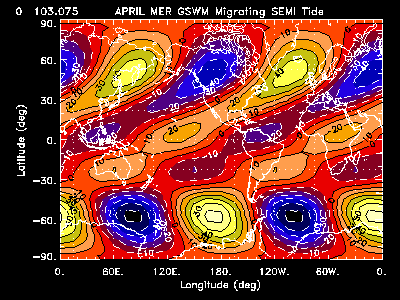
Animation cycles three times (three solar days). [ESC] to stop, Reload to replay.

This view shows that the migrating tide does not change with longitude, but repeats the same pattern at each longitude over time (alternatively, it changes in time exactly the same way at each longitude). The tide propagates westward.
The two cycles of the tide (two positive and two negative maxima) are obvious in this view. So is the phase difference across the equator which causes maxima in opposite hemispheres to have opposite directions. The amplitude in the fall hemisphere (S) is greater than that in the spring (N).
Compare the number of peaks and their relatively high magnitude at the poles with the diurnal meridional tide at 100km, which is stronger near the equator. Also, note the phase difference in the semidiurnal meridional winds (January) altitude/latitude cross section.